Microsoft NEM-2 GSM850/1900 Cellular Telephone User Manual 3300 Music Phone
Microsoft Mobile Oy GSM850/1900 Cellular Telephone 3300 Music Phone
Contents
- 1. Manual part 1
- 2. Manual Part 2
- 3. Manual part 2
- 4. Manual part 3
- 5. Manual part 4
Manual part 1
[ 1 ]
User Guide for
Nokia 3300 Music Phone
FCC DRAFT

[ 2 ]
The wireless phone described in this guide is approved for use in 850 and 1900 GSM networks.
LEGAL INFORMATION
Part No. 9355979, Issue No. 1
Copyright ©2003 Nokia. All rights reserved.
Nokia, Nokia Connecting People, Nokia 3300, and the Nokia Original Accessories logos are
trademarks or registered trademarks of Nokia Corporation. All other product and company
names mentioned herein may be trademarks or tradenames of their respective owners.
Printed in Canada June/2003
US Patent No 5818437 and other pending patents.
T9 text input software Copyright ©1999-2003. Tegic Communications, Inc. All rights reserved.
Includes RSA BSAFE cryptographic or security protocol software from RSA
Security.Java is a trademark of Sun Microsystems, Inc.
The information in this user guide was written for the Nokia 3300 phone.
Nokia operates a policy of ongoing development. Nokia reserves the right to
make changes and improvements to any of the products described in this
document without prior notice.
UNDER NO CIRCUMSTANCES SHALL NOKIA BE RESPONSIBLE FOR ANY LOSS OF
DATA OR INCOME OR ANY SPECIAL, INCIDENTAL, AND CONSEQUENTIAL OR
INDIRECT DAMAGES HOWSOEVER CAUSED.
THE CONTENTS OF THIS DOCUMENT ARE PROVIDED “AS IS.” EXCEPT AS REQUIRED BY
APPLICABLE LAW, NO WARRANTIES OF ANY KIND, EITHER EXPRESS OR IMPLIED, INCLUDING,
BUT NOT LIMITED TO, THE IMPLIED WARRANTIES OF MERCHANTABILITY AND FITNESS FOR A
PARTICULAR PURPOSE, ARE MADE IN RELATION TO THE ACCURACY AND RELIABILITY OR
CONTENTS OF THIS DOCUMENT. NOKIA RESERVES THE RIGHT TO REVISE THIS DOCUMENT OR
WITHDRAW IT AT ANY TIME WITHOUT PRIOR NOTICE.
EXPORT CONTROLS
This product contains commodities, technology or software exported from the United States in
accordance with the Export Administration regulations. Diversion contrary to U.S. law is
prohibited.
FCC/INDUSTRY CANADA NOTICE
Your phone may cause TV or radio interference (for example, when using a telephone in close
proximity to receiving equipment). The FCC or Industry Canada can require you to stop using
your telephone if such interference cannot be eliminated. If you require assistance, contact
your local service facility. This device complies with part 15 of the FCC rules. Operation is
subject to the condition that this device does not cause harmful interference.
[ 1 ]
Contents
Contents 1
Appendix A Message from the CTIA163 8
Appendix B Message from the FDA 167 8
For your safety 9
General information 11
Overview of functions 11
Digital music player and recorder 11
Stereo radio 11
Music key 12
Loudspeaker 12
Polyphonic sound 12
MIDP JavaTM applications 12
Instant Messaging and E-Mail 12
13
Multimedia messaging service (MMS) 13
General packet radio service (GPRS) 13
Nokia OTA settings service 13
Memory card 14
Access Codes 14
Security code 14
PIN code and PIN2 code 14
PUK and PUK2 codes 15
Restriction password 15
Shared memory 15
Accessibility solutions 15
Network Services 16
About enhancements 16
Understand your phone 17
Keys and Connectors 17
Keys 17
17
17
17
[ 2 ]
17
17
17
Connectors 19
Standby mode 19
Wrist strap 22
Headset 22
Data cables 23
Getting started 25
Install the SIM card and battery 25
Remove and install the memory card 27
Charge the battery 28
Switch the phone on and off 29
Keypad lock (Keyguard) 30
Change the covers 30
Music functions 33
Listen to music 33
Listen to the radio 35
Call functions 37
Make a call 37
Make a call using the Contacts list 37
Last number redialing 37
Call your voice mailbox 38
1-touch dialing 38
Vanity dialing 38
Answer or decline an incoming call 38
Make a conference call 39
Options during a call 40
Contacts 41
Contact settings 41
Saving contacts and phone numbers (Add name) 41
Search for a name in Contacts 43
Editing a contact, number or text item 43
Erasing names and numbers 43
Copying Contacts lists 44
Sending and receiving a business card 44
[ 3 ]
1-touch dialing 45
Info numbers (delete this? not in menu) 45
Service numbers 45
My numbers 45
Caller groups 46
Messages (Menu 1) 47
Menu functions 47
Access a menu function 47
Scroll to a menu 47
Menu shortcuts 47
Messages (Menu 1) 48
Text messages 49
Write and send messages 49
Write text 50
Tips for writing text 51
Options for sending a message 52
Write and send e-mail 52
Read and reply to a message 53
Inbox and outbox folders 54
Templates 55
Insert a text template into a message or an e-mail 55
Insert a picture into a text message 55
Archive folder and my folders 55
Multimedia messages 56
Write and send a multimedia message 57
Read and reply to a multimedia message 58
Inbox, Outbox, Saved and Sent items folders 59
Multimedia messages memory full 59
Erase messages 59
Use Instant messaging 60
Set up Instant messaging 61
Instant messages 61
Chat Sessions 62
Contacts 64
Add a new contact 64
Remove a contact 65
[ 4 ]
Private Groups 66
IM settings 67
Log Off Service 70
Voice messages 70
Info messages 70
Message settings 71
Overwrite settings 72
Settings for multimedia messages 72
Receive the multimedia connection settings as a text message 73
Font size setting 73
Service commands 73
Call log (Menu 2) 75
Recent calls lists 75
Call counters and call timers 76
Profiles (Menu 3) 79
Settings (Menu 4) 81
Time and date settings 81
Clock 81
Date 81
Auto update of date and time 81
Call settings 82
Call Forwarding 82
Anykey answer 82
Automatic redial 82
1-touch dialing 82
Call waiting 83
Summary after call 83
Send my caller identity 83
Line for outgoing calls 83
Phone settings 84
Language 84
Automatic keyguard 84
Cell info display 84
Welcome note 85
System selection 85
[ 5 ]
Confirm SIM service actions 85
Help text activation 85
Start-up tone 85
Music settings 85
Equalizer 85
Balance 86
Loudness 86
Stereo widening 86
Restore default music settings 86
Display settings 86
Wallpaper 86
Color schemes 87
Operator logo 87
Screen saver timeout 87
Display brightness 88
Tone settings 88
Enhancement settings 89
Headset 89
TTY/TDD 89
Security settings 89
Restore factory settings 90
Right selection key settings 90
Go to selection key 91
91
Music (Menu 6) 93
Music player 93
Listening to music 94
Track list 95
Radio 96
Tune a radio station 97
Use the radio 97
Recorder 98
Record 98
Recording list 99
Music settings 99
Nokia Audio Manager 100
[ 6 ]
System requirements 101
Installing Nokia Audio Manager 101
Saving CD tracks with Nokia Audio Manager 102
Transferring music files to your phone 102
Other features 103
Transfer music files
using Windows Explorer 103
Create a playlist 106
106
Organizer (Menu 8) 107
Alarm clock 107
Calendar 107
Making a calendar note 108
When the phone alarms for a note 109
To-do list 109
Gallery (Menu 7) 111
Games (Menu 9) 113
Launching a game 113
Other options available for a game or game set 114
Game downloads 114
Memory 115
Settings 115
Applications (Menu10) 117
Launching an application 117
Other options available for an application or application set 118
Downloading an application 118
Memory status for applications 119
Extras (Menu 11) 121
Backup/Restore 121
Back up data to a memory card 121
Restore data from a memory card 122
Calculator 122
Making a currency conversion 123
Voice recorder 123
[ 7 ]
Voice commands 124
Use the voice commands 125
Countdown timer 125
Stopwatch 125
Memory card 127
Services (Menu 12) 129
Basic steps for accessing and using WAP services 129
Set up the phone for a WAP service 130
Making a connection to a WAP service 132
Browsing the pages of a WAP service 133
Ending a WAP connection 135
Appearance settings of WAP browser 135
Cookie settings 135
Bookmarks 136
Service inbox 137
Cache memory 137
Authority certificates 138
SIM services (Menu 13) 139
Reference information 141
Battery statements 141
Charging and Discharging 141
Use proper CARE AND MAINTENANCE 142
Understand IMPORTANT SAFETY INFORMATION 143
Traffic Safety 143
Operating environment 143
Electronic devices 144
Other medical devices 145
Vehicles 145
Posted facilities 145
Potentially explosive atmospheres 145
Vehicles 146
Emergency calls 147
Certification Information (SAR) 148
Use Accessories safely 149
Accessories 150
[ 8 ]
Frequently Asked Questions 151
Glossary 151
Technical information 153
Troubleshooting 154
Appendix A
Message from the CTIA
(Cellular Telecommunications & Internet Association)
to all users of mobile phones. 163
Appendix B Message from the FDA (U.S. Food and
Drug Administration) to all users of mobile phones. 167
Appendix A Message from the CTIA163
Appendix B Message from the FDA 167

[ 9 ]
1 For your safety
Read these simple guidelines. Breaking the rules may be dangerous or
illegal. Further detailed information is given in this manual.
Do not switch the phone on when wireless phone use is
prohibited or when it may cause interference or danger.
ROAD SAFETY COMES FIRST
Don't use a hand-held phone while driving.
INTERFERENCE
All wireless phones may get interference, which could affect
performance.
SWITCH OFF IN HOSPITALS
Follow any regulations or rules. Switch the phone off near
medical equipment.
SWITCH OFF IN AIRCRAFT
Wireless devices can cause interference in aircraft.
SWITCH OFF WHEN REFUELING
Don't use the phone at a refueling point. Don't use near fuel or
chemicals.
SWITCH OFF NEAR BLASTING
Follow any restrictions or rules. Don't use the phone where
blasting is in progress.
USE SENSIBLY
Use only in the normal position as shown in the user guide.
Don't touch the antenna unnecessarily.

[ 10 ]
1QUALIFIED SERVICE
Only qualified personnel should repair this device.
ENHANCEMENTS AND BATTERIES
Use only approved enhancements and batteries. Do not
connect incompatible products.
CONNECTING TO OTHER DEVICES
When connecting to any other device, read its user's guide for
detailed safety instructions. Do not connect incompatible
products.
BACKUP COPIES
Remember to make backup copies of all important data.
WATER-RESISTANCE
Your phone is not water-resistant. Keep it dry.
CALLING
Ensure the phone is switched on and in service. Enter the phone
number, including the area code, then press . T o e n d a c a l l ,
press . To answer a call, press .
EMERGENCY CALLS
Ensure the phone is switched on and in service. Press as
many times as needed (e.g. to exit a call, to exit a menu, etc.)
to clear the display. Enter the emergency number, then press
. Give your location. Do not end the call until told to do so.
WARNING
Do not use stereo headphones when your attention is required
for safety purposes.

[ 11 ]
2 General information
Overview of functions
The Nokia 3300 Music Phone provides many functions for daily use, such
as the digital music player and recorder, FM stereo radio, calendar, (alarm)
clock, calculator, and many more. You can also change the look of your
phone with Nokia Xpress-onTM color covers. See Change the covers.
Digital music player and recorder
Your phone has a digital music player and recorder. You can listen to
music using a stereo headset or with the loudspeaker. Record your
favorite music from the radio or from external audio equipment such as a
CD player. The music tracks that you record are saved on a memory card
in your phone. See Music functions.
You can transfer music files to your phone once you have installed Nokia
Audio Manager PC software which is on the CD-ROM that comes with
your phone. The DKU-2 USB cable is used to connect your phone and your
PC.
You can connect your phone to your PC with the USB cable and transfer
files with Windows Explorer. The memory card file can be seen in a
removeable drive on your PC. Just drag and drop saved AAC or MP3 music
files to the memory card in your phone from Windows Explorer.
Stereo radio
Your phone has an integrated FM stereo radio. You can listen to the radio
using a headset or using the loudspeaker. The headset, which functions
at the antenna, must be connected to turn on the radio. See Listen to the
radio.

[ 12 ]
2Music key
Your favorite music is only one button press away. The special music key
on the top left of your phone gives you access to all the music
features with one hand. The music key allows you to turn on the music
player or the radio without going through the phone menu. This key is also
a quick way to switch between the music player and the radio, or to turn
the music off.
Loudspeaker
You can use the internal loudspeaker to listen to music and the radio.
Polyphonic sound
Polyphonic sound consists of several sound components played at the
same time. Polyphonic sounds can be used in ringing tones and message
alert tones. Your phone has sound components from over 128 instruments
that can be used for polyphonic sounds. The phone can play 24 of these
instruments simultaneously and supports scalable polyphonic MIDI (SP-
MIDI) format.
You can receive polyphonic ringing tones via multimedia service or a WAP
download. See Read and reply to a multimedia message, or download ring
tones through the gallery menu. See Gallery.
MIDP JavaTM applications
Your phone supports JavaTM and contains some Java applications and
games that have been specially designed for mobile phones. You can
download new applications and games from different WAP services. See
Applications (Menu10).
Instant Messaging and E-Mail
Your Nokia 3000 Music phone has full-featured Instant Messaging and e-
mail capabilities. With Instant Messaging (IM) you can talk with your
friends while viewing the conversation. The e-mail enables you to access
your personal e-mail account (POP3/IMAP4) from your phone. As your
service provider for details on IM and e-mail.

[ 13 ]
2
Multimedia messaging service (MMS)
The phone is able to send multimedia messages composed of text and a
picture, and to receive messages containing text, a picture and sound. You
can save the pictures and ringing tones for personalizing your phone. See
Messages (Menu 1).
General packet radio service (GPRS)
GPRS technology allows mobile phones to send and receive data over a
mobile network and access data networks like the Internet.
GPRS uses a technology called packet data. Data files are sent in short
bursts over the mobile system instead of in a continuous stream. This way,
the system is busy only when sending or receiving data. Because GPRS
uses the system more efficiently, data connections are set up quickly and
data is transferred at faster speeds.
Applications that use GPRS are WAP services, MMS, text messaging,
instant messaging, e-mail, and Java application downloading.
Contact your service provider to find out about subscribing to GPRS. They
can also give you detailed information on the cost of using a GPRS
connection and the cost of different applications such as MMS, text
messaging, and WAP services.
Nokia OTA settings service
In order to use WAP, MMS, GPRS, and other wireless services, you need to
have special settings on your phone. You may receive the settings directly
as an OTA message, and then only need to save the settings on your
phone. Or, the settings for these services may be preset by your service
providers. For more information on availability of the settings, contact
your service provider.

[ 14 ]
2Memory card
Your Nokia 3300 Music Phone comes with a pre-installed 64-MB MMC
(MultiMedia Card) to store your music files and ringing tones. You can use
memory cards with up to 128 MB of memory in your phone. For
compatibility, use only memory cards approved by Nokia.
You can also back up and restore your contact and calendar data, text and
multimedia messages, applications, games, and your personal user
settings to and from a memory card. See Remove and install the memory
card and Backup/Restore.
Access Codes
Security code
The security code supplied with your phone (5—10 digits) protects your
phone against unauthorized use. The preset code is 12345. Change the
code, and keep the new code secret and in a safe place separate from your
phone. To change the code, and to set the phone to request the code, see
Security settings
PIN code and PIN2 code
The PIN (personal identification number) code (4—8 digits) protects your
SIM card against unauthorized use. The PIN code is usually supplied with
the SIM card.
Set the phone to request the PIN code each time the phone is switched
on. See Security settings.
The PIN2 code may be supplied with the SIM card and is required to access
some functions, such as charging unit counters.
If you key in an incorrect PIN code three times in succession, the phone
may display SIM blocked and ask you to enter the PUK code. Contact your
service provider to obtain the PUK code.

[ 15 ]
2
PUK and PUK2 codes
The PUK (personal unblocking key) code (8 digits) is required to change a
blocked PIN code. The PUK2 code is required to change a blocked PIN2
code.
If the codes are not supplied with the SIM card, contact your local service
provider for the codes.
Restriction password
The restriction password (4 digits) is needed when using the Call
restriction service, see Security settings. You can obtain the password
from your service provider.
Shared memory
The following features in this phone may share memory: Contacts, text
and multimedia messages, images and ringing tones in gallery, calendar,
to-do notes, and Java games and applications. Using any of these features
may reduce the memory available for any features sharing memory. This
is especially true with heavy use of any of the features. Some of the
features may have a certain amount of memory specifically allotted to
them in addition to the amount of memory shared with other features. For
example, saving many images or Java applications may take all of the
shared memory and your phone may display a message that the memory
is full. In this case, delete some of the information or entries stored in the
shared memory features before continuing.
Accessibility solutions
Nokia is committed to making mobile phones easy to use for all
individuals, including those with disabilities. For more information, visit
the Nokia World Wide Web site: www.nokiaaccessibility.com.
This user guide is available in alternate formats. To request any format,
call Nokia customer Care at (888) 665-4228.
TTY/TDD users can contact Nokia at (800) 246-6542.

[ 16 ]
2Network Services
The wireless phone described in this guide is approved for use on the GSM
850 and 1900 networks.
Dual band is a network-dependent feature. Check with your local service
provider if you can subscribe to and use this feature.
A number of features included in this guide are called Network Services.
These are special services that you arrange through your wireless service
provider. Before you can take advantage of any of these Network Services,
you must subscribe to them through your service provider and obtain
instructions for their use from your service provider.
Note: Some networks may not support all language-
dependent characters and services.
About enhancements
Check the model number of any charger before using it with this device.
This device is intended for use when supplied with power from the
ACP-7 travel charger or the ACP-12 standard charger.
Warning: Use only batteries, chargers, and
accessories approved by the phone manufacturer for
use with this particular phone model. The use of any
other types may invalidate any approval or warranty
applying to the phone, and may be dangerous.
For availability of approved accessories, please check with your dealer.
When you disconnect the power cord of any accessory, grasp and pull the
plug, not the cord.

[ 17 ]
3 Understand your phone
Keys and Connectors
Keys
1
1Power key
The power key switches the phone on and off.
When the keypad is locked, press the power key to light the display
for approximately 15 seconds.
2Volume key
The volume key turns the volume up or down on the earpiece, the
headset, and the loudspeaker.
3Music key
The music key takes you to the Music player and FM radio without
going through the menu. You can also switch the music off with this
1
2
3
4
5
6

[ 18 ]
3key.
a) Short press and long press of the music key
The first short press of the music key will take you to the music
menu.
b) Once you are in the music menu, a short press switches or scrolls
through the menu choices (Music player, Radio, and Switch music
off). The choices are highlighted as you move or switch from one
menu choice to the next.
c) A long press on a highlighted choice selects and starts the music
player or radio, or switches the music off.
4Four-way scroll key
Up , down , left and right
Use the scroll key to scroll through contact names, phone numbers,
menus or settings. You can also do a station search in the radio, adjust
the music settings, and access music functions, such as play, stop, fast
forward, and rewind.
While listening to the music player or radio, press to skip
backwards to the previous recording or previous radio station.
Press to skip forward to the next recording or radio station.
In standby mode, press to go to the first name stored in Contacts.
Press to go to the last name stored in Contacts. Press to go
to Messages to create a new message. Press to go to a calendar of
the current month with the current day highlighted. You can also
scroll up and down to see previous and future months.
5Selection keys and
In standby mode the selection keys are Menu and Contacts. As you
go through the menus, the selection keys give you different options.
For example, if you press the selection key below Contacts, you will
see Select and Exit.
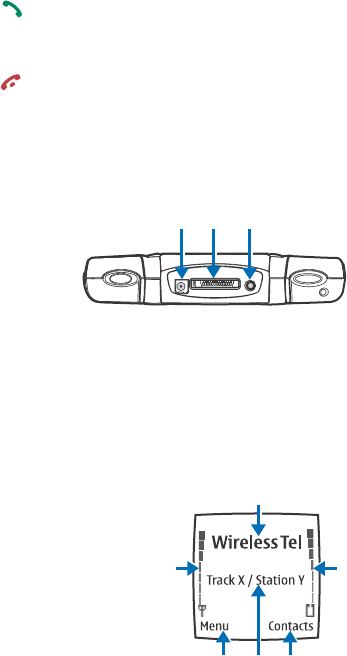
[ 19 ]
3
6Send and End keys
Press the send key to dial a phone number or answer a call. If you
press this key in standby mode, it shows the last phone number you
dialed.
Press the end key to end a call. This key is also a quick way to
exit from any function.
Connectors
1Charger connector
2Pop-PortTM connector for
headsets, the USB data cable,
and loopset
3Audio ADE-2 recording cable
connector to connect the
phone to external audio
equipment such as a CD
player or PC
Standby mode
The phone is in standby mode when it is on and ready to use, but you have
not entered any numbers or characters.
1Indicates the cellular system that is in
use.
2Shows the signal strength of the cellular
system at your current location. The
higher the bar, the stronger the signal.
3Shows the battery charge level. The
higher the bar, the more power in the
battery.
4The left selection key in standby mode is
Menu.
5The right selection key in standby mode is Contacts.
1 2 3
1
23
4 6 5

[ 20 ]
36When the music player is on, the track title is shown. When the radio
is on, the radio station is shown.
You can show the time and date in standby mode. See Clock and Date for
instructions. Also see Icons in standby mode.
Screen saver
Your phone has an automatic screen saver for saving power in standby
mode. A digital clock is displayed when no phone functions are in use. You
can set the timer to activate the screen saver. See Screen saver timeout.
To deactivate the screen saver, press any key.
If you have not set the time, 00:00 is displayed. To set the time, see Clock.
Wallpaper
You can select and set a wallpaper or background picture to display when
the phone is in standby mode. See Wallpaper.
Icons in standby mode
The following list shows different icons seen on the screen in standby
mode to let you know you have received messages or which settings are
active.
You have received one or more text or picture
messages. See Read and reply to a message.
You have received one or more multimedia
messages. See Read and reply to a message.
You have received one or morel voice messages.
See Voice messages.
The phone keypad is locked.
See Keypad lock (Keyguard).
The phone does not ring at an incoming call or text
message when Incoming call alert is set to Off and
Message alert tone is set to Off. See Tone settings.

[ 21 ]
3
The alarm clock is set to On.
See Alarm clock.
The countdown timer is running.
See Countdown timer.
The stopwatch timer is running in the background.
See Stopwatch.
A GPRS connection is established. The indicator is
shown on the top left of the display.
The GPRS connection is on hold, for example, if
there is an incoming or outgoing call during a GPRS
connection.
All your calls are forwarded to another number,
Forward all voice calls. If you have two phone lines,
the forward indicator for the first line is and
for the second line . See Call Forwarding.
or If you have two phone lines, indicates the selected
phone line. See Line for outgoing calls.
The loudspeaker has been activated.
Track name The music player is on.
Radio station
name
The radio is on.
Calls are limited to a closed user group.
See Security settings.
The timed profile is selected.
See Profiles (Menu 3).
A headset accessory is connected to the phone.
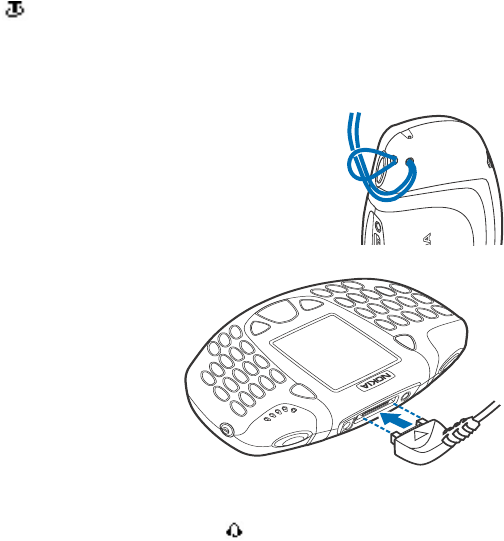
[ 22 ]
3
Wrist strap
You can attach a wrist strap to your phone.
Thread the strap through the holes behind the
music key as shown in the picture, and pull to
tighten.
Headset
Connect
Insert the plug connector
of the headset cable into
the Pop-PortTM connector
on the top of the phone.
The cable is connected
correctly when the
arrowhead points toward
the display screen and
the cord falls toward the
music key on the left
side.
When the headset is connected, appears on the screen.
Disconnect
Remove the headset cable from the Pop-PortTM connector by grasping the
plug (not the cord) and pulling it out.
A loopset accessory is connected to the phone.

[ 23 ]
3
Wear the HDS-3H stereo headset as shown
in the picture.
The headset cable functions as the radio
antenna, so let it hang freely.
Answer a call with the headset
Press the headset key to answer and end a
call.
Headset button
Press the headset button to change tracks
while listening to the music player, or to
change stations while listening to the
radio.
A long press of the headset button activates voice recognition for voice
tags you have saved.
Warning: Do not use the HDS-3H Stereo Headset while
driving. Note that when using this headset, your ability
to hear outside sounds is reduced. DRIVING WHILE
USING THIS HEADSET CAN ENDANGER YOUR SAFETY.
Data cables
You can connect your phone to a compatible PC with the supplied DKU-2
USB data cable (1). The cable is connected correctly when the arrowhead
points toward the display screen and the cord falls toward the music key
on the left side.
Important: Disconnect the USB data cable from the
phone to make a call.
Use the Nokia Audio Manager software to handle your music files and
transfer them from the PC to the memory card in your phone. See Nokia
Audio Manager. You can also drag and drop music files from your PC to a
folder created when you first connect the USB data cable.
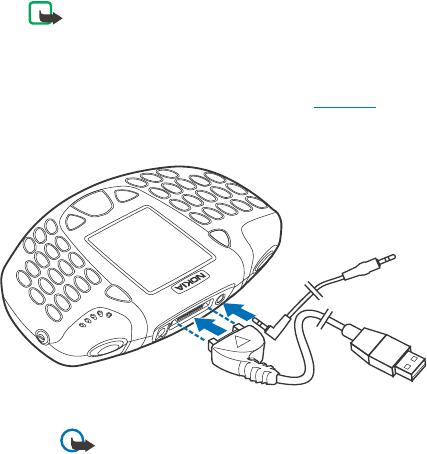
[ 24 ]
3Note: Close all applications on the phone and disconnect
the audio line-in cable before connecting your phone to a
PC with the USB data cable.
To record music, you can connect your phone to external audio equipment
with the supplied ADE-2 recording cable (2). See Recorder.
Important: Do not connect the USB cable to your PC
before you have installed the Nokia Audio Manager
PC software from the CD-ROM.
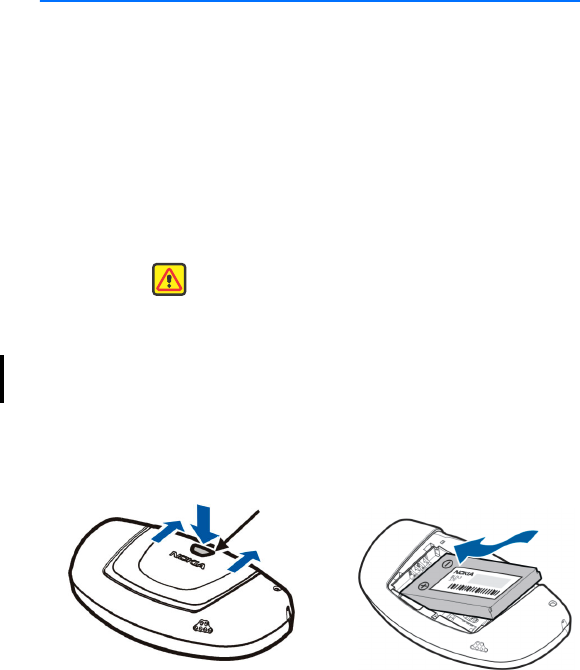
[ 25 ]
4 Getting started
Install the SIM card and battery
Before you install the SIM card, make sure the phone is switched off.
The SIM card and the gold contacts on the card can be damaged by
scratches or by bending the card. Be careful when inserting, removing or
handling the card.
Warning:Keep all miniature SIM cards out of the
reach of small children.
1Remove the back cover of the phone with the back of the phone
facing you. Press the back cover release button (1) and slide the cover
forward.
2Insert the battery with the gold contacts on the battery aligned with
the gold contacts in the battery slot. (2).
(1) Cover release button (2) Insert
battery
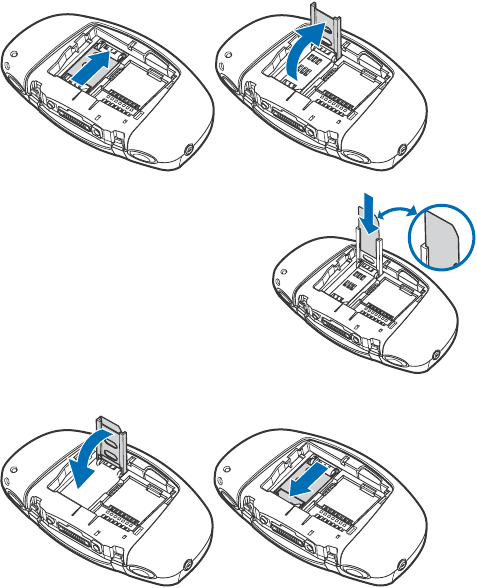
[ 26 ]
43Slide the SIM card holder down (3) and pull up to open(4).
4Insert the SIM card into the SIM card
holder (5). The SIM card is inserted
correctly with the bevelled corner on
the card up. The gold contact area on
the card is facing the connectors on
the phone.
5Close the SIM card holder (6) and push up to lock (7).
34
5
67

[ 27 ]
4
6Replace the battery (8).
To replace the back cover, insert the locking catches on the back cover
in the corresponding slots in the phone. Slide the cover until it locks
into place (9).
Remove and install the memory card
Your phone comes with a 64 MB pre-installed and ready-to-use memory
card.
Important: Keep all memory cards out of the reach of small children.
1Make sure the phone is switched off.
2With the back of the phone facing you, slide the cover open and
remove the battery. See step 1 in Install the SIM card and battery.
3To remove the memory card, press the memory card release button (1)
and lift the card off (2). Be careful not to scratch the gold contacts on
the card.
89
12
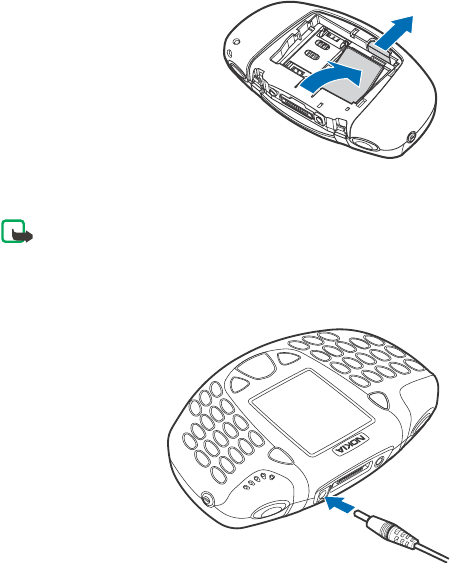
[ 28 ]
4To install the memory card,
gently press the memory card in
place (3) while pressing the
memory card release button (4).
Make sure that the gold
contacts of the card are facing
down.
4Replace the battery and cover.
Note: Do not remove the memory card in the middle of an
operation. Be sure to close all memory card applications
before removing the card.
Charge the battery
1Connect the lead from
the charger to the socket
on the top of your phone.
2Connect the charger to
an AC wall socket.
The text Charging is
displayed briefly if the
phone is switched on. If
the battery is completely
discharged, it may take a
few minutes before the
charging indicator appears on the display or any calls can be made.
You can use your phone while the charger is connected.
Charging time depends on the charger and the battery used. For example,
charging a BLD-3 battery with the ACP-12 charger takes up to one hour
and 30 minutes while the phone is in standby mode.
3
4
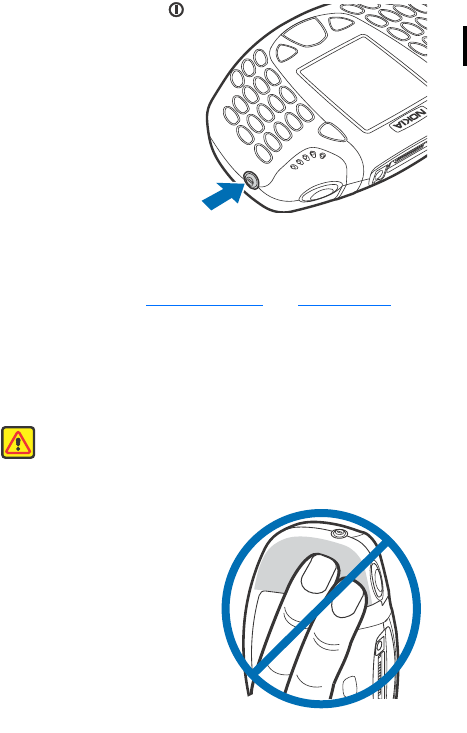
[ 29 ]
4
Switch the phone on and off
Press and hold the power key
located on the right side of your phone
until the display lights come on.
If the phone displays Insert SIM card
even though the SIM card is properly
inserted, or SIM card not supported,
contact your service provider. Your
phone does not support 5 Volt SIM
cards and the card may need to be
changed.
• If the phone asks for a PIN code, key in the PIN code (displayed as ****),
and press OK.
See also PIN code request in Security settings and Access Codes.
• If the phone asks for a security code, key in the security code
(displayed as *****), and press OK.
Also see Access codes. Change the security code, PIN code, PIN2 code
or restriction password. Codes can only include numbers from 0 to 9..
Warning: Do not switch the phone on when wireless
phone use is prohibited or when it may cause
interference or danger.
Tip: EFFICIENT OPERATION: Your phone
has a built-in antenna. As with any
other radio transmitting device, do
not touch the antenna
unnecessarily when the phone is
switched on. Contact with the
antenna affects call quality and
may cause the phone to operate at

[ 30 ]
4a higher power level than otherwise needed. Not touching the
antenna area during a phone call optimizes the antenna
performance and the talktime of your phone.
Keypad lock (Keyguard)
You can lock the keypad to prevent the keys being accidentally pressed
when you are carrying your phone.
Lock the keypad
In standby mode, press the left
selection key under Menu and
then within 1.5 seconds.
Unlock the keypad
Press the left selection key
under Unlock and then
within 1.5 seconds.
If you receive a call while the
keypad is locked, you do not need to unlock it to answer a call. Press ,
and during a call, the phone can be operated normally. When you end or
reject a call, the keypad will automatically remain locked.
For automatic keypad lock, see Automatic keyguard.
For locking the keypad during a call, see Options during a call.
Note:When Keyguard is on, calls may be possible to the
emergency number programmed into your phone (such as
911 or other official emergency numbers). Key in the
emergency number and press . The number is displayed
only after you have keyed in the last digit.
Change the covers
Before changing the cover, always switch off the power and disconnect
the phone from the charger or any other device. Always store and use the
phone with the covers attached. (ESD explanation)

[ 31 ]
4
1 Remove the back
cover.
2 To remove the front
cover, gently pull the
cover on both sides (1)
and remove the cover
starting from the top
(2).
3Remove key mat from
the front cover and
replace on the phone
(3).
1
1
1
2
2
3
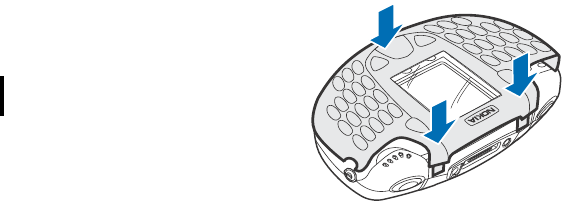
[ 32 ]
44To replace the front cover,
first place the catches on
the lower part of the cover
into the corresponding
holes in the phone (4).
Then gently press the cover
into place (5).
5Replace the back cover.
4
5
5
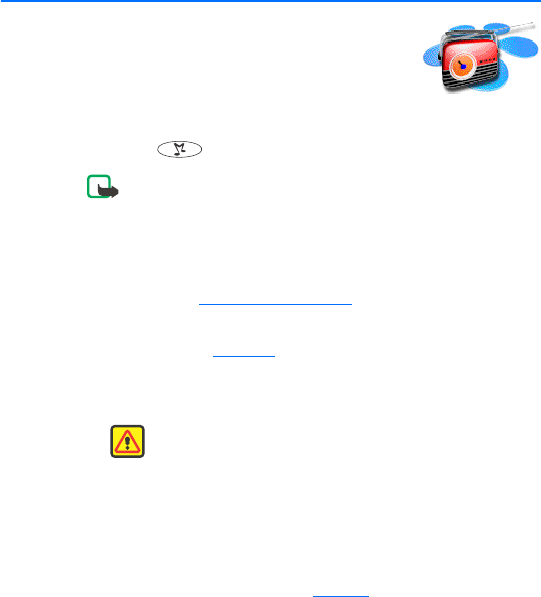
[ 33 ]
5 Music functions
You can listen to music stored on the memory card in
your phone with the Music player, or you can listen to
the FM stereo radio. You can turn the Music player on and off with the
special music key located on the top left of your phone.
Note:Your phone must be switched on to use this function.
Do not switch the phone on when wireless phone use is
prohibited or when it may cause interference or danger.
You can use the Nokia Audio Manager software to create and organize
digital music files on a compatible PC and transfer them to the memory
card in your phone. See Nokia Audio Manager for instructions.
You can also record music from the radio or an external music source, for
example, a CD player. See Recorder for instructions.
To adjust the playback volume, use the Volume key on the top right of the
phone.
Warning: Listening to music at a high volume may
damage your hearing.
Listen to music
You can listen to music on the Loudspeaker or with headphones. To
connect the headset to your phone, See Headset.
Press the Music key and select Music player. Use the functions of the
four-way scroll key as described in the following table.
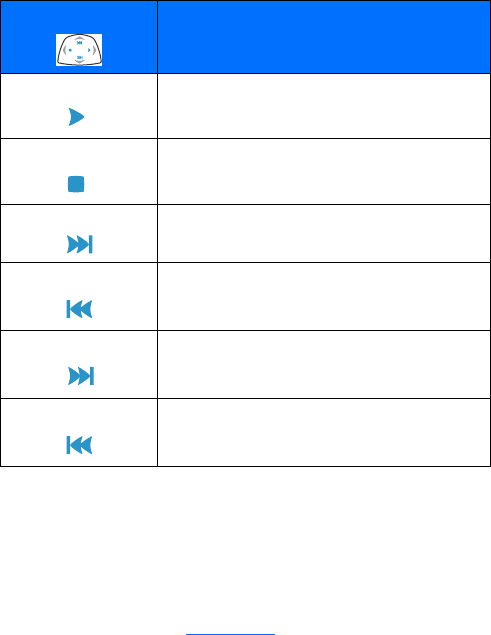
[ 34 ]
5
Press Options to open a list of available Music player options. For
example, from the Options list you can select Loudspeaker to listen to
music with the internal loudspeaker.
To turn the Music player off, press the Music key and select Switch music
off.
For more information, see Music player.
Four-way scroll key
Music functions
Play
Stop
Fast forward, press and hold
Rewind, press and hold
Skip to the next track
Skip to the previous track

[ 35 ]
5
Listen to the radio
To listen to the FM radio, you must first connect the headset. The headset
also functions as the radio antenna. For the best reception, allow it to
hang freely.
1Press the Music key and select Radio.
2To tune a station, press and hold or and the station search
starts. Searching stops when a station is found.
3Press Options to open a list of the available options.
For example, from the Options list you can select Set frequency to
manually key in the frequency of a radio station.
For more information, see Radio.
[ 36 ]
5
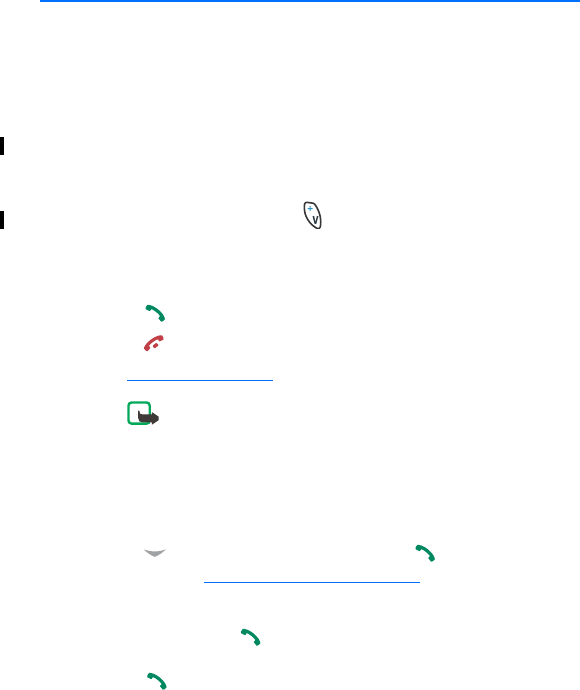
[ 37 ]
6 Call functions
Make a call
1The number keys are located on the right side of the the keyboard. Key
in the phone number, including the area code. If you key in an
incorrect number, press Clear to delete it.
For international calls, press for the international prefix (the +
character replaces the international access code) and then key in the
country code, area code without the leading 0, if necessary, and the
phone number.
2Press to call the number.
3Press to end the call or to cancel the call attempt.
See Options during a call.
Note: If you are listening to music and receive a call, the
music player and the radio are temporarily muted. When
you end the call, the music player and radio are
automatically turned back on.
Make a call using the Contacts list
Press Contacts and select Find. Scroll to the number you wish to call
using the on the four-way scroll key. Press to call the number
on the display. See Search for a name in Contacts.
Last number redialing
In standby mode, press once to access a list of the last 20 numbers
you called or attempted to call. Scroll to the number or name you want,
and press to call the number. Calls you dialed from numbers stored
in your Contacts list will appear with the name you saved for the number.
Calls you dialed that are not stored in Contacts will appear with the
phone number.

[ 38 ]
6Call your voice mailbox
In standby mode, press and hold , or press and .
If the phone asks for the voice mailbox number, key in the number
(obtained from your service provider) and press OK. See Voice messages.
1-touch dialing
You can assign a phone number to one of the 1-touch dialing keys, from
2 to 9. See 1-touch dialing.
1Go to Contacts and select the number you want to assign a 1-touch
dialing key.
2Select Details to see the phone number.
3Select Options and scroll to 1-touch dialing. Select a number from 2
to 9 and select Assign.
To call the number in standby mode, press the 1-touch dialing key you
wish to call and press . If the 1-touch dialing function is set to On:
Press and hold the corresponding 1-touch dialing key until the call is
started. See 1-touch dialing.
Vanity dialing
You can dial a phone number that is alphanumeric (using both letters and
numbers). For example, many 800 numbers are advertised with a name
such as +1-800-CALLNOW. You can enter the numbers and letters, and
the phone will automatically dial the corresponding numbers for the
letters you enter.
To use this feature:
1Press the to enter the + symbol.
2Then enter 1 and 800.
3Press the key and enter the letters, such as CALLNOW.
4Press to make the call.
Answer or decline an incoming call
Press to answer the incoming call and press to end the call.

[ 39 ]
6
Press to decline the incoming call.
If you press Silence, only the ringing tone is muted. Then either answer or
decline the call.
If the headset HDS-3H or HDS-3 is connected to the phone, you can
answer and end a call by pressing the headset key.
Tip: If the Forward if busy function is activated to forward
the calls, for example to your voice mailbox, declining an
incoming call will also forward the call. See Call Forwarding.
Call waiting
During a call, press to answer the waiting call. The first call is put on
hold. Press to end the active call.
To activate the Call waiting function, see Call waiting.
Make a conference call
Conference calling is a system service that allows you to make a
conference call with a maximum of six participants, including yourself.
1Make a call to the first participant.
2To make a call to a new participant, press Options and select New call.
3Key in, or search the memory for the phone number of the new
participant and press Call. The first call is automatically put on hold.
4When the new call has been answered, join the first participant in the
conference call. Press Options and select Conference.
5To add a new person to the call, repeat steps 2 to 4.
6To have a private conversation with one of the participants:
Press Options and select Private and select the desired participant.
Rejoin the conference call as described in step 4.
7To end the conference call, press .

[ 40 ]
6Options during a call
Many of the options that you can use during a call are system services.
Press Options during a call for some of the following options:
Mute or Unmute, End call, End all calls, Contacts, Menu and Hold or
Unhold, New call, Conference, Private, Answer, Decline and Handset.
Lock keypad to activate the keypad lock.
Send DTMF to send DTMF tone strings, for example, passwords or bank
account numbers. Key in the DTMF string or search for it Contacts and
press OK. Note that you can key in the wait character w and the pause
character p by repeatedly pressing .
Swap to switch between the active call and the call on hold, Transfer to
connect a call on hold to an active call, and disconnect yourself from the
calls.

[ 41 ]
7 Contacts
You can save names and phone numbers in the phone’s memory (internal
phone book) and in the SIM card’s memory (SIM phone book).
The internal phone book may save up to 500 names with numbers and
text notes for each name.
Note:Contacts uses shared memory. See Shared memory.
The phone supports SIM cards that can save up to 500 names and phone
numbers. Names and numbers saved in the SIM card’s memory, are
indicated by .
Contact settings
Press Contacts and select Settings. Select
•Memory in use to select the Contacts list you want to use. To recall
names and numbers from both lists, select Phone and SIM. The names
and numbers will be saved in the phone and SIM memory. Or you can
select to save in either the Phone or SIM card.
•Contacts view to select how the names (and numbers) in the Contacts
list are displayed.
•Memory status to see how many names and phone numbers are
currently saved and how many can still be saved in the selected phone
book.
Saving contacts and phone numbers (Add name)
Names and numbers will be saved in the used memory. See Contact
settings above.
1Press Contacts and select Add contact.

[ 42 ]
72Key in the name and press OK.
3Key in the phone number, and press OK. To key in the numbers, see
Make a call.
4When the name and number are saved, press Done.
Tip: In standby mode, key in the phone number. Press
Options, and select Save. Key in the name, press OK and
Done.
Saving multiple numbers and text items per name
You can save different types of phone numbers and short text items per
name in the phone’s internal phone book.
The first number saved is automatically set as the default number and it
is indicated with a frame around the number type indicator, for example
. When you select a name from Contacts, for example to make a call,
the default number is used unless you select another number.
1Make sure that the memory in use is either Phone or Phone and SIM.
See Selecting the phone book settings.
2To access the list of names and phone numbers, press or in
standby mode.
3Scroll to the name saved in the phone’s internal phone book to which
you want to add a new number or text item, and press Details.
4Press Options and select Add number or Add detail.
5Select one of the following number types:
General, Mobile, Home, Work and Fax,
or text types:
E-mail address, Web address, Street address and Note.
6To change the number or text type, select the item you want to
change. Key in the number or text item and press OK to save it.
7Press Back and then Exit to return to standby mode.

[ 43 ]
7
Changing the primary number
If you have several numbers for one contact, you can select one of the
numbers as the primary number, or the number you use most often. The
primary number is highlighted and is the first in the list. When you select
this contact, the primary number is used unless you scroll to an alternate
number.
1Press or in standby mode, scroll to the name you want and press
Details.
2Scroll to the number you want to set as the primary number. Press
Options and select As primary number.
Search for a name in Contacts
1Press Contacts and select Find.
2You can key in the first characters of the name you are searching for
in the pop-up window.
Press and to scroll through the names in the list, and and
to move the cursor in the pop-up window.
3Scroll to the name you want, and press Details. Scroll to view the
details of the selected name.
Tip: To quickly find a contact and phone number, press or
in standby mode. Key in the first letter(s) of the name,
and/or scroll to the name you want.
Editing a contact, number or text item
Search for the contact name (and number) you want to edit and press
Details. Scroll to the name, number or text item you want to edit, and
press Options. Select Edit name, Edit number, or Edit detail, and edit the
name, number, or text and press OK.
Erasing names and numbers
Press Contacts and select Delete.
• To delete contact names and numbers one by one, select One by one

[ 44 ]
7and scroll to the name (and number) you want to delete. Press Delete
and press OK to confirm.
• To delete contact names and numbers all at once, select Delete all.
Then select Phone or SIM card and press Delete. Press OK and confirm
with the security code.
Copying Contacts lists
You can copy names and phone numbers from the phone’s memory to
your SIM card’s memory and vice versa.
1Press Contacts and select Copy.
2Select the copying direction, From phone to SIM card or From SIM
card to phone.
3Select One by one, All or Primary numbers.
If you select One by one, scroll to the name you want to copy and
press Copy.
Primary numbers is shown if you copy from the phone to the SIM card.
Only the Primary numbers will be copied.
4To choose whether you want to keep or delete the original names and
numbers, select Keep original or Move original.
If you select All or Primary numbers, press OK when Start copying? or
Start moving? is displayed.
Sending and receiving a business card
You can send and receive a person’s contact information as a business
card as an Over The Air (OTA) message if supported by the network.
Receiving a business card
When you have received a business card as an OTA message, press Show.
Press Save to save the business card in the phone’s memory. To discard the
business card, press Exit and then OK.

[ 45 ]
7
Sending a business card
You can send a business card as an OTA message to a compatible phone
or other handheld device which supports the vCard standard.
1Search for the name and phone number you want to send from
Contacts, press Details and Options and select Send bus. card.
2To send the business card as an OTA message, select Via text message.
1-touch dialing
To make a call by using the 1-touch dialing keys, see 1-touch dialing.
Assigning a number to a 1-touch dialing key
Press Contacts, select 1-touch dialing and scroll to the 1-touch dialing
key number you want.
Press Assign, press Search, and select first the name and then the number
you want to assign. If a number is already assigned to the key, press
Options, and you can view, change or delete the assigned number.
Info numbers (delete this? not in menu)
You can call the information numbers of your service provider if the
numbers are included in your SIM card.
Press Contacts and select Info numbers. Scroll in a category to an
information number and press to call the number.
Service numbers
You can call the service numbers of your service provider if the numbers
are included in your SIM card.
Press Contacts and select Service numbers. Scroll to a service number and
press to call the number.
My numbers
The phone numbers assigned to your SIM card are saved in My numbers if
this is allowed by the card. To view the numbers press Contacts and select
My numbers. Scroll to the desired name or number, and press View.

[ 46 ]
7Caller groups
You can arrange the contacts and phone numbers saved in Contacts into
caller groups. For each caller group, you can set the phone to sound a
specific ringing tone and show a selected graphic on the display when you
receive a call from a phone number in the group, see below. To set the
phone to ring only upon calls from phone numbers belonging to a selected
caller group, see Alert for in Tone settings.
Press Contacts, and select Caller groups and select the desired caller
group. Select
•Group name, key in a new name for the caller group and press OK.
•Group ringing tone and select the ringing tone for the group. Default
is the ringing tone selected for the currently active profile.
•Group logo and select On to set the phone to display the group logo,
Off not to display it, or View to view the logo.
•Group members to add a name to the caller group, press Options and
select Add name. Scroll to the name you want to add to the group and
press Add.
To remove a name from a caller group, scroll to the name you want
to remove, and press Options and select Remove name.

[ 47 ]
8 Messages (Menu 1)
Menu functions
Your phone offers an extensive range of functions which are grouped in
menus. Most of the menu functions are provided with a brief help text. To
view the help text, scroll to the menu function you want and wait for 15
seconds. To exit the help text, press Back. See Help text activation.
Access a menu function
Scroll to a menu
1To access the menu, press Menu.
2Scroll with or through the menu and select, for example,
Settings by pressing Select.
3If the menu contains submenus, select the one you want, for example
Call settings.
4If the selected submenu contains further submenus, repeat step 3.
Select the next submenu, for example Call forwarding.
5Select the setting of your choice.
6Press Back to return to the previous menu level, and Exit to exit the
menu.
Menu shortcuts
The menus, submenus and setting options are numbered and you can
access them by using their shortcut number.
To access the menu, press Menu. Key in quickly, within two seconds, the
index number of the menu function you want to access.
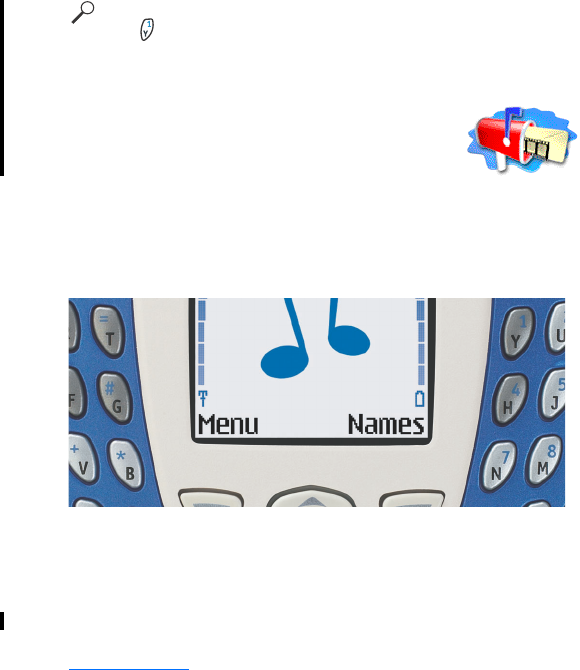
[ 48 ]
8Example: To set Create message in Text Messages, press Menu, 011
and . Press Back to return to the previous menu levels, and Exit
to exit the menu.
Messages (Menu 1)
Your Nokia 3300 Music phone has a special messaging
keypad designed to make text messaging fast and easy
to use. The keys are arranged the same as a PC keyboard, with the display
screen centered between the left-hand and right-hand keys. The size and
shape of the phone make it comfortable to hold and easy to use two hands
for keying in characters.
You can read, write, send and save text, multimedia, and e-mail messages.
All your messages are organized into separate folders for each type of
message.
Before you can send any text or picture messages, you need to save your
message center number, given to you by your service provider. See
Message settings.

[ 49 ]
8
Text messages
A standard text message can be up to 160 characters in length. If you
want to send a long text message (more than 160 characters), you can
enter 160 characters in up to five messages that are sent as a series of
linked messages. The number of available characters and the current part
number of a linked message are shown on the top right of the display. For
example: 160/1; 125/2; 136/3; 125/4; and 125/5.
When the message is received, it is displayed as one text message. For
this feature to work, the receiving phone must also support linked
messages. Contact your service provider to subscribe to this type of text
messaging. Charges for linked messages are based on the number of
standard text messages linked together.
You can also send and receive text messages that contain pictures. Each
picture message is also made up of several text messages. Just like
sending linked text messages, sending one picture message may cost
more.
Note: The picture message function can be used only if it
is supported by your service provider. Only phones that
offer picture message features can receive and display
picture messages.
Write and send messages
1Press Menu, and select Messages, Text messages and Create message.
Tip: To quickly open the message editor, press in standby
mode.
2Key in a message. See Write text. To insert text templates or a picture
into the message, see Templates.
3To send the message, press Options and select Send.
4Enter the recipient’s phone number or search for the phone number
in Contacts.
Press OK to send the message.
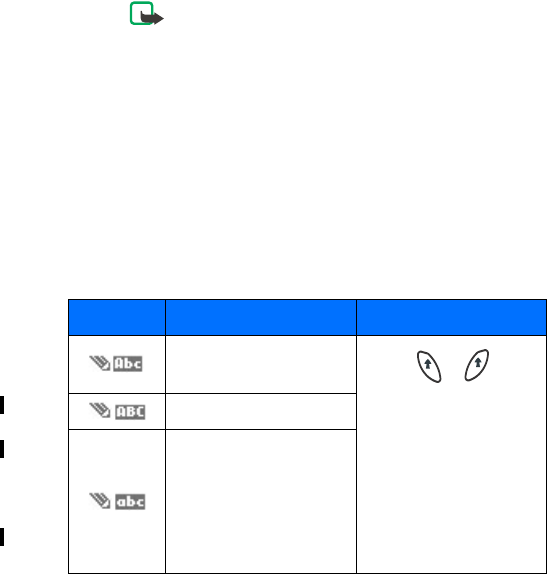
[ 50 ]
8Note: When sending messages via the SMS network
service, your phone may display the words Message sent.
This is an indication that the message has been sent by
your phone to the message center number programmed
into your phone. This is not an indication that the
message has been received at the intended destination.
For more details about SMS services, check with your
service provider.
Write text
When you write text messages, you can use several special keys for
capitalizing words and switching to number mode. The following table
shows indicators displayed at the top left of the screen in messaging.
Indicator Function of indicator Special keys
First letter of the word
is capitalized
Use ths key to change
between First cap, ALL
CAPS, and no caps.
There are two of these
keys. They are located
on the bottom row of
keys on the left and
right.
All letters capitalized
No capitalized letters
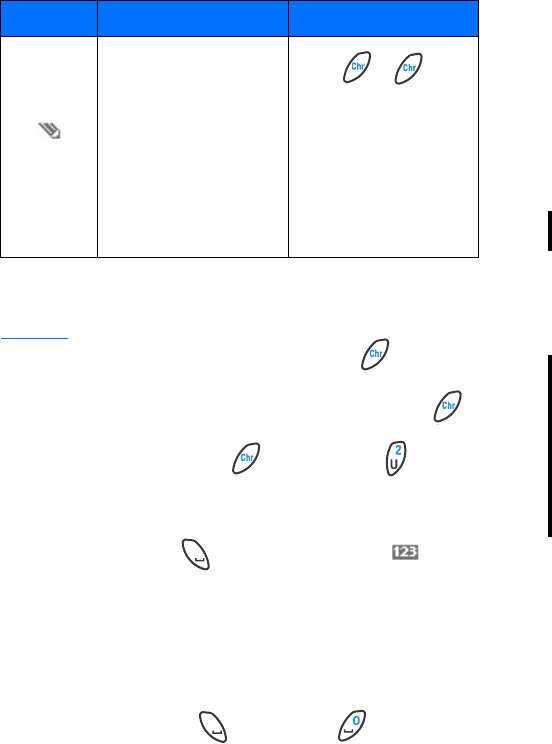
[ 51 ]
8
Not all characters available are printed on the keys. The characters
available depend on the language selected in the Language menu. See
Language .
• To insert a number while in letter mode, press . Press twice to
lock.
• To see all the characters available on a key, press and hold while
pressing the key several times in a row.
For example, press and hold . Then press the .
On the first press, 2 is displayed. On the second press, u is displayed.
• The most common punctuation marks and special characters are
available by pressing when the number mode is selected.
Or press Options and select Insert symbol.
Use the four-way scroll key to select the character you want and then
press Insert.
Tips for writing text
The following functions are also available for writing text:
• To insert a space, press on the left, or on the right.
• To move the cursor to the left, right, up, or down,
N
Number mode
new graphic needed
Use this key to change
between letter and
number mode. There
are two of these keys.
They are located on the
bottom row of keys on
the left and right.
Indicator Function of indicator Special keys

[ 52 ]
8press , , or on the scroll key, respectively.
• To delete a character to the left of the cursor, press Clear. Press and
hold Clear to delete the characters more quickly.
To delete all the characters at once when writing a message, press
Options and select Clear text.
Options for sending a message
After you have written a message, press Options and select Sending
options.
• To send a message to one person, use one of the following options:
• To insert a number while in letter mode, press Options and select
Insert number. Key in the phone number, or find it in Contacts
and press OK.
• To insert a name from Contacts , press Options and select Insert
name. To insert a phone number or a text item attached to the
name, press Options and select View details.
• To send a message to several recipients, select Send to many. When
you have sent the message to everyone you want to send it to, press
Done.
• To send a message using a message profile, select Sending profile and
then the desired message profile, such as Profile 2 or Profile 3.
To define a message profile, see Message settings.
Write and send e-mail
Before you can send e-mail via SMS, you need to save the settings for
sending e-mail. See Message settings. For availability and subscription to
e-mail service, contact your service provider. To save an e-mail address in
Contacts, see Saving multiple numbers and text items per name.
1Press Menu, and select Messages, Text messages and Create e-mail.
2Key in the recipient’s e-mail address or search for it Contacts and
press OK.

[ 53 ]
8
3If you wish, you can key in the subject for the e-mail and press OK.
4Key in the e-mail message. See Write text. The total number of
characters that you can key in is shown on the top right of the display.
The e-mail address and subject are included in the total number of
characters.
Also see Insert a text template into a message or an e-mail. Pictures
cannot be inserted.
5To send the e-mail, press Options and select Send e-mail. If you have
not saved the settings for sending e-mails, the phone asks for the
number of the e-mail server.
Press OK to send the e-mail.
Note: When sending e-mails via the SMS network service,
your phone may display the words Message sent. This is an
indication that the e-mail has been sent by your phone to
the e-mail server. This is not an indication that the e-mail
has been received at the intended destination. For more
details about e-mail services, check with your service
provider.
Read and reply to a message
When you have received a message, the indicator and the number of
new messages followed by message(s) received is shown.
The blinking indicates that the message memory is full. Before you
can receive new messages, delete some of your old messages.
The text messages function uses shared memory, see Shared memory.
1Press Show to view the new message, or press Exit to view it later.
To read a message later oress Menu, and select Messages, Text
messages and Inbox.
2If more than one message has been received, select the one that you
want to read. An unread text message is indicated by in front of
it and a picture message that has not been viewed is indicated by .

[ 54 ]
83While reading or viewing the message, press Options.
You can select an option, for example, to delete, forward or edit the
message. You can also move and rename the message you are
reading.
Select Copy to calendar to copy text at the beginning of the message
to your phone’s calendar as a reminder note for the current day.
Select Message details to view the sender’s name and phone number,
the message center used, and the date and time of receipt.
Select Use detail to extract numbers, e-mail addresses and website
addresses from the current message.
When reading a picture message, select Save picture to save the
picture in the Templates folder.
4Select Reply to reply to a message. Select Original text to include the
original message in the reply, or select a standard answer ( to be
included in the reply, or select Empty screen.
When replying to an e-mail, confirm or edit the e-mail address and
subject first. Then write your reply message.
5Press Options, select Send, and press OK to send the message to the
displayed number.
Inbox and outbox folders
The phone saves incoming text messages in the Inbox folder and sent
messages in the Sent items folder of the Text messages submenu.
Text messages that you wish to send later can be saved in the Archive, My
folders or Templates folder.

[ 55 ]
8
Templates
Your phone includes text templates, indicated by , and picture
templates, indicated by . Text templates are messages you can use
quickly without having to key in all the text, such as “I’m in a meeting,
please call me later at.” All you need to do is add a time.
To access the template list, press Menu, and select Messages, Text
messages and Use template (for text templates), or Insert picture.
Insert a text template into a message or an e-mail
• When you are writing or replying to a message or an e-mail, press
Options. Select Use template and select the template that you want
to insert.
Insert a picture into a text message
• When you are writing or replying to a message, press Options. Select
Insert picture and select a picture to view it. Press Insert to insert the
picture into your message. The indicator in the header of the
message indicates that a picture has been attached. The number of
characters that you can enter in a message, depends on the size of the
picture.
To view the text and the picture together before sending the message,
press Options and select Preview.
Archive folder and my folders
To organize your messages, you can move some of them to the Archive
folder, or add new folders for your messages.
While reading a message, press Options. Select Move, scroll to the folder
that you want to move the message to and press OK.
To add or delete a folder, press Menu, and select Messages and My folders.

[ 56 ]
8• To add a folder, press Options and select Add folder.
• To delete a folder, scroll to the folder that you want to delete, press
Options and select Delete folder.
Multimedia messages
Note: This function can be used only if it is supported by
your network operator or service provider. Only phones
that offer multimedia message features can receive and
display multimedia messages.
A multimedia message can contain text, picture and sound. The phone
supports multimedia messages that are up to 64 KB in size. If the
maximum size is exceeded, the phone may not be able to receive the
message. Depending on the network, you may receive a text message that
includes an Internet address where you can view the multimedia message.
If the message contains a picture, the phone scales it down to fit the
display area.
Note: If Allow multimedia reception is set to Yes, your
operator or service provider may charge you for every
message you receive.
Multimedia messaging supports the following formats:
• Picture: JPEG, GIF, PNG, and BMP.
• Sound: MIDI, Scalable Polyphonic MIDI (SP-MIDI), monophonic
ringing tones (RGN) and true tones (WB-AMR).
If a received message contains any unsupported elements, they may be
replaced with the file name and the text Object format not supported.

[ 57 ]
8
Note that you are not able to receive any multimedia messages if you
have a call in progress, a game or another Java application running, or an
active WAP connection over GSM data. See Key in the service settings
manually. Because delivery of multimedia messages can fail for a variety
of reasons, do not rely solely upon them for essential communications.
Write and send a multimedia message
To add the settings for multimedia messaging, see Settings for multimedia
messages. For availability and a subscription to the multimedia messaging
service, contact your service provider.
1Press Menu, and select Messages, Multimedia msgs. and Create
message.
2Key in a message. See Write text.
You can insert one picture in a multimedia message. To insert a
picture, press Options, and select Insert image. The list of available
folders in the Gallery is shown. To open a specific folder, select it and
then select the desired picture. The indicator in the header of the
message indicates that a picture has been attached.
To insert a name from Contacts, press Options, select More options
and Insert name. Scroll to the desired name, press Options and select
Insert name.
To insert a number, press Options, select More options and Insert
number. Key in the number or search in Contacts, and press OK.
3To view the message before sending it, press Options and select
Preview.
4To send the message, press Options and select Send to number (or
Send to e-mail).
5Enter the recipient’s phone number (or e-mail address) or search for
it in Contacts. Press OK and the message is moved to the Outbox
folder for sending.

[ 58 ]
8It takes more time to send a multimedia message than to send a text
message. While the multimedia message is being sent, the animated
indicator is displayed and you can use other functions on the phone.
If there is an interruption while the message is being sent, the phone tries
to resend it a few times. If this fails, the message will remain in the
Outbox folder and you can try to resend it later.
The messages that you have sent will be saved in the Sent items folder if
the setting Save sent messages is set to Yes. See Settings for multimedia
messages.
Read and reply to a multimedia message
When your phone is receiving a multimedia message, the animated
indicator is displayed. When the message has been received, the
indicator and the text Multimedia message received are shown.
The blinking indicates that the memory for multimedia messages is
full, see Multimedia messages memory full.
The multimedia message function uses shared memory, see Shared
memory.
1Press Show to view the message, or press Exit to view it later.
Reading the message later: Press Menu, and select Messages,
Multimedia msgs. and Inbox.
2Scroll to view the message. Press Options and some of the following
options may be available.
•Delete message to delete a saved message.
•Reply to reply the message. To send the reply, press Options and select
Send. The sender’s phone number (or e-mail address) is used as the
default value.
•Forward to no. or Forward to e-mail to forward the message to a
phone number or e-mail address.
•Edit to edit a message. You can only edit messages you have written.
See Write and send a multimedia message.

[ 59 ]
8
•Message details to view the subject, size and class of the message.
•Play to listen to the ringing tone that is contained in the message.
•Save sound clip to save the ringing tone in the Gallery.
•Zoom in to increase the size of the picture that is contained in the
message.
•Save image to save the picture in the Gallery.
Inbox, Outbox, Saved and Sent items folders
The phone saves the multimedia messages that have been received in the
Inbox folder of the Multimedia msgs. submenu.
Multimedia messages that not yet been sent are moved to the Outbox
folder of the Multimedia msgs. submenu.
The multimedia messages that you wish to send later, can be saved in the
Saved items folder of the Multimedia msgs. submenu.
The multimedia messages that have been sent are saved in the Sent items
folder of the Multimedia msgs. submenu.
Multimedia messages memory full
When you have a new multimedia message waiting and the memory for
the messages is full, the indicator blinks and Multimedia memory full,
view waiting msg. is shown. To view the waiting message, press Show. To
save the message, press Options, select Save message and delete old
messages by first selecting the folder and then an oId message to be
deleted.
To discard the waiting message, press Exit and Yes. If you press No, you
can view the message.
Erase messages
1To delete text messages, press Menu, and select Messages, Text
messages and Delete messages.

[ 60 ]
8To delete multimedia messages, press Menu, and select Messages,
Multimedia msgs. and Delete messages.
2To delete all messages in a folder, scroll to the folder and press OK.
Then press OK when Delete all read messages from folder? is
displayed.
To delete all read messages from all folders, scroll to All read and press
OK. Then press OK when Delete read messages from all folders? is
displayed.
Use Instant messaging
You can now take text messaging to the next level by experiencing instant
messaging in a wireless environment. You can engage in instant
messaging with friends and family, regardless of the mobile system or
platform (like the Internet) they are using. It’s different from using SMS
or email addresses to send messages because you can have a true, two-
way conversation. The contact list feature shows you when your friends,
family members, and colleagues are online and available to exchange
instant messages. Simply select the name, write the message, and send it.
Your message stays on the screen. When you get a reply, it appears on the
screen, above your original message, so you can track the conversation.
Each message is priced as a text message.
Before you can start using instant messaging, you must first subscribe to
the text messaging service and get a unique ID and password from your
service provider.
Note: Since instant messaging may not be available from
your wireless service provider, the Instant messaging
screen may not appear. Contact your service provider for
details and availability.

[ 61 ]
8
Set up Instant messaging
The first time you use instant messaging, you will need to choose a
provider, create a unique ID, and a password.
Choose provider
Log in for the first time
1Press Menu 1-4 (Messages > Instant messaging), press Options,
then select Open.
Opening application appears.
2Scroll to Login, press Select.
The User ID: screen appears.
3Enter your ID name your service provider gave you, press Options,
then select OK.
The Password screen appears.
4Enter your password, press Options, then select OK.
5Press Yes to allow web access.
Logging in appears briefly, Logged in appears and the Instant
messaging menu displays.
You can use automatic login after you have set up your your ID name and
password. See Set up automatic login for information on setting up
automatic login.
Instant messages
Write and send instant messages
New contact
1After you are logged in, select IM contacts, then Add new contacts.
2Scroll to Write to other and press Select.
3Enter the unique ID and press OK.

[ 62 ]
84Go to Step 3 in Chat session from the IM contacts view.
For names that are already in your contacts list, go to Chat Sessions.
Receive instant messages
When you’re logged on, you can receive IMs from others while you’re
exchanging IMs with friends, an unlisted Screen Name, while your phone
is in standby mode, or while you’re using another phone feature.
Phone in standby mode
When the phone receives a message, New instant message appears.
1Press Read to see the message
The screen name of the person who sent the IM appears with their
message.
OR
Press Exit to ignore the message.
2To reply, press Options, select Enter text, then write your reply.
3Press Options and select Send, or press the Send key to send the
reply.
Chat Sessions
Chat session from the IM contacts view
1From the Instant messaging menu, scroll to IM contacts and press
Select.
2Scroll the contact with whom you want to chat.
3Press Options and select Chat.
4Press Options., select Enter text and enter a message.
5Select Send.
The Conversation view appears with the contact’s name inside the
input window.
6After your contact replies, repeat steps 4 and 5 to continue your chat
session.

[ 63 ]
8
Chat session from the inbox view
You can only initiate a chat session from this view, if an active chat is
open or has been saved. See Save chat history for information on saving
chat sessions.
1From the Instant messaging menu, scroll to Inbox and press Select.
2Scroll the contact with whom you want to chat.
3Press Options and select Chat.
4Press Options., select Enter text and enter a message.
5Select Send.
The Conversation view appears with the contact’s name inside the
input window.
6After your contact replies, repeat steps 4 and 5 to continue your chat
session.
Quit chat session
If you want to end your chat session, perform the following steps:
1From the Conversation view, press Back, then press Options.
2Scroll to End convers. and press Select.
Conversation ended appears.
Save chat history
If you want to save your chat session (chat history), perform the following
steps:
1From the Conversation view, press Options, then select Save.
The Conversation name: screen appears.
2Enter the name you want to use for the conversation and press
Options.
3Select Save
History saved appears.
[ 64 ]
8View chat history
1From the Instant messaging menu, scroll to Saved convers. and press
Select.
2Scroll to the chat history you want to view, then press Select.
Rename chat history
1From the Instant messaging menu, scroll to Saved convers. and press
Select.
2Scroll to the chat history you want to rename, then press Select.
3Press Options, then select Rename.
4Press Clear as many times as necessary to delete the current chat
history name.
5Press Options, then select OK.
Conversation renamed appears.
Delete chat history
1From the Instant messaging menu, scroll to Saved convers. and press
Select.
2Scroll to the chat history you want to rename, then press Select.
3Press Options, then select Delete.
Conversation deleted appears.
Contacts
Instant messaging allows you to maintain a list of people with whom you
want to interact. You can send messages to any of the people in your list,
called the contact list, as long as that person is online.
Add a new contact
1From the Instant messaging menu, scroll to IM contacts and press
Select.
2Press Options, then select Add contact.
[ 65 ]
8
The Unique ID screen appears.
3Enter the contact’s ID name, press Options, then select OK.
The Nickname screen appears.
4Enter the contact’s nickname, press Options, then select OK.
Updating information appears briefly, then Added appears.
Remove a contact
1From the Instant messaging menu, scroll to IM contacts and press
Select.
2Scroll to the contact name you want to remove.
3Press Options, then select Remove contact.
A message appears, asking if you want to remove the contact.
4Press OK.
Updating information appears briefly, then a confirmation note
appears.
Block messages from a contact
1Fromthe Instant messaging menu, scroll to IM contacts and press
Select.
2Scroll to the contact from whom you want to block messages.
3Press Options, then select Block messages.
A message appears, asking if you want to block messages from the
contact.
4Press OK.
Updating information appears briefly, then a confirmation note
appears.
Unblock messages from a contact
1Fromthe Instant messaging menu, scroll to IM contacts and press
Select.
[ 66 ]
82Scroll to the contact from whom you want to unblock messages.
3Press Options, then select Unblock.
A message appears, asking if you want to block messages from the
contact.
4Press OK.
Updating information appears briefly, then a confirmation note
appears.
Private Groups
You can take part in private chat groups
Create private group
1Fromthe Instant messaging menu, scroll to Create group and press
Select.
The Group name: box appears.
2Enter the group’s name, press Options, then select OK.
The Screen name: box appears.
3Enter your screen name, press Options, then select OK.
Updating information appears briefly, then a confirmation note
appears.
Add members to private group chat
1While in the group members screen, press Add.
The Contacts list appears.
2Scroll to the contact you want to add to the group and press Select.
A confirmation message appears.
3Repeat steps 1 and 2 above for each new group member.
4When finished, press Back to return to the group members screen.
Send invitations to private group chat
1While in the group members screen, press Options.
[ 67 ]
8
2Scroll to Send invitation and press Select.
The Invitation box appears.
3Enter your invitation and press OK.
The invitation goes to all group members? and a confirmation
appears. When a group member accepts the invitation, XX joined
appears.
Group members can also decline invitations with or without sending
a notice (see Reject invitations to group chat below). A decline notice
appears as XX rejected invitation. If the group member gives a
reason, that text appears also.
Remove private group members
1While in the group members screen, scroll to the group name you
want to delelte and press Options.
2Scroll to Remove from group and press Select.
3Press OK when the confirmation appears.
Act on invitations to group chat
When the phone receives the invitation, New instant message appears.
1Press Read to see the message.
The group name appears with the text of the invitation.
2Press Options to see the sender’s name, and the date and time you
received the inv
Reject invitations to group chat
IM settings
You can customize your IM settings. Here is how the menu options
appear:
•Screen name
•Automatic login

[ 68 ]
8• Contacts order (?)
•Presence settings
• Network settings (?)
Set up screen name
You can set up or revise a screen name that is 1–20 characters in length.
Note: You must enter at least one character for your
screen name. A blank screen name is not allowed. You must
have a screen name to be able to join a group chat.
1Press Menu 12 (Instant messaging), press Options, then select Open.
Opening application appears.
2Scroll to IM Settings, press Select.
3Scroll to Screen name, press Select.
The Screen name: screen appears.
4Enter your screen name, press Options, then select OK.
Screen name saved appears.
Set up automatic login
You can use automatic login after you have set up your your ID name and
password.
1Press Menu 12 (Instant messaging), press Options, then select Open.
Opening application appears.
2Scroll to IM Settings, press Select.
3Scroll to Automatic login, press Select and select On launch.
The next time you open instant messaging, perform the following steps.
1Press Yes to allow web access.
2Select Login.
Logging in appears briefly, Logged in appears and the Instant
messaging menu displays.
[ 69 ]
8
Set up contacts order
1Press Menu 12 (Instant messaging), press Options, then select Open.
Opening application appears.
2Scroll to IM Settings, press Select.
3Scroll to Contacts ordering, press Select.
4Select either Alphabetic or By status, then press Select.
Set up presence status
Presence allows you and other users to know who is online and available
to chat.
To update your presence status, perform the following steps:
1Press Menu 12 (Instant messaging), press Options, then select Open.
Opening application appears.
2Scroll to IM Settings, press Select.
3Scroll to Presence settings, press Select, then select Updates.
4Select either Off or On, then press Select.
To set your presence authorization, perform the following steps:
1Press Menu 12 (Instant messaging), press Options, then select Open.
Opening application appears.
2Scroll to IM Settings, press Select.
3Scroll to Presence settings, press Select, then select Authorization.
4Select either Group members or All, then press Select.
A confirmation note appears.
View network settings

[ 70 ]
8Log Off Service
You can either exit Instant messaging, but stay connected or you can log
out and become disconnected.
Voice messages
Voice mailbox is a network service and you may need to subscribe to it.
For more information and for the voice mailbox number, contact your
service provider.
Press Menu, and select Messages and Voice messages. Select:
•Listen to voice messages to call your voice mailbox at the phone
number that you have saved in the Voice mailbox number menu.
Each phone line may have its own voice mailbox number, see Line for
outgoing calls.
•Voice mailbox number to key in, search for or edit your voice mailbox
number and press OK to save it.
If supported by the network, the indicator will show new voice
messages. Press Listen to call your voice mailbox number.
Tip: Pressing and holding calls your voice mailbox.
Info messages
With the info message network service you can receive messages on
various topics from your service provider, for example weather or traffic
conditions. For available topics and the relevant topic numbers, contact
your service provider.

[ 71 ]
8
If the GPRS connection is set to Always online, the info messages may not
be received. In that case, set the GPRS connection to When needed. See
Settings when GPRS is the selected data bearer.
Message settings
The message settings affect the sending, receiving and viewing of
messages.
Settings for text messages
1Press Menu, and select Messages, Message settings, Text messages
and Sending profile.
2If more than one message profile set is supported by your SIM card,
select the set you want to change.
•Select Message center number to save the phone number of the
message center that is required for sending text messages. You
will receive this number from your service provider.
•Select Messages sent as to select the message type Text, E-mail,
Paging or Fax.
•Select Message validity to select the length of time for which the
network should attempt to deliver your message.
• For message type Text, select Default recipient number to save a
default number for sending messages for this profile.
For message type E-mail, select E-mail server to save the e-mail
server number.
•Select Delivery reports to ask the network to send delivery reports
for your messages (network service).
•Select Use GPRS to set GPRS as the preferred SMS bearer.
•Select Reply via same center to allow the recipient of your
message to send you a reply via your message center (network
service).

[ 72 ]
8•Select Rename sending profile to change the name of the selected
message profile. The message profile sets are only displayed if
your SIM card supports more than one set.
Overwrite settings
When the text message memory is full, the phone cannot receive or send
any new messages. However, you can set the phone to automatically
replace old text messages in the Inbox and Sent items folders with the
new ones.
Press Menu, and select Messages, Message settings, Text messages and
Overwriting in inbox or Overwriting in sent items. Select Allowed to set the
phone to replace the old text messages with new ones in the Inbox or the
Sent items folder, respectively.
Settings for multimedia messages
Press Menu, and select Messages, Message settings and Multimedia msgs.
Select
•Save sent messages. Select Yes to set the phone to save sent
multimedia messages in the Sent items folder. If you select No, the
sent messages are not saved.
•Allow multimedia reception. Choose No, Yes or In home network to
use multimedia service. If you choose In home network, you cannot
receive multimedia messages when outside your home network.
•Incoming multimedia messages. Select Retrieve to set the phone to
automatically fetch newly received multimedia messages, or select
Decline if you do not wish to receive multimedia messages.
•Connection settings. Define WAP connection settings for retrieving
multimedia messages. Activate the set where you want to save the
connection settings and then edit the settings.
•Settings' name. Key in the new name for the connection set and
press OK.
•Homepage. Key in the homepage address of the WAP service that
you want to use, press for a dot, and press OK.

[ 73 ]
8
•Session mode. Select Permanent or Temporary.
•Data bearer. Select GPRS.
•GPRS access point. Key in the access point name and press OK. An
access point name is needed to establish a connection to a GPRS
network. You obtain the access point name from your network
operator or service provider.
•IP address. Key in the address, press for a dot, and press OK.
You obtain the IP address from your network operator or service
provider.
•Authentication type. Select Secure or Normal.
•User name. Key in the user name and press OK.
•Password. Key in the password and press OK.
•Allow adverts. You can receive or decline advertisements.
Receive the multimedia connection settings as a
text message
You may receive the service settings as a text message from the network
operator or service provider that offers the WAP service that you want to
use. For more information, contact your network operator or service
provider.
Font size setting
To select the font size for reading and writing messages, press Menu, and
select Messages, Message settings, Other settings and Font size.
Service commands
Press Menu, and select Messages and Service commands. Key in and send
service requests (also known as USSD commands), such as activation
commands for network services, to your service provider.
[ 74 ]
8

[ 75 ]
9 Call log (Menu 2)
The phone logs the phone numbers of missed, received
and dialed calls, and the approximate length and cost
of your calls.
The phone logs missed and received calls only if the network supports
these functions, the phone is switched on and within the network’s
service area.
When you press Options in the Missed calls, Received calls and dialed
numbers menu, you can, for example, view the date and the time of the
call, edit or delete the phone number from the list, save the number in
Contacts, or send a message to the number.
Recent calls lists
Press Menu, and select Call log and then select
•Missed calls to view the list of the last ten phone numbers from which
somebody has tried to call you (network service). The number in front
of the (name or) phone number indicates the amount of call attempts
from that caller.
Tip: When a note about missed calls is being displayed, press
List to access the list of phone numbers. Scroll to the
number you would like to call back and press .
•Received calls to view the list of the last ten phone numbers from
which you have most recently accepted calls (network service).
•Dialed numbers to view the list of the 20 phone numbers that you
have most recently called or attempted to call. See also Last number
redialing.
•Delete recent call lists to delete the recent calls lists. Select whether
you want to delete all the phone numbers in the recent call lists, or

[ 76 ]
9only those numbers in the missed calls, received calls or dialed
numbers lists. You cannot undo the operation.
Call counters and call timers
Note: The actual invoice for calls and services from your
service provider may vary, depending upon network
features, rounding-off for billing, taxes and so forth.
Press Menu, and select Call log and then select
•Call duration, scroll to view the approximate duration of your
incoming and outgoing calls in hours, minutes and seconds. To clear
the timers, the security code is needed.
Each phone line has its own call timers and the timers of the selected
line are displayed. See Line for outgoing calls.
•Call costs (network service). Select Last call units or All calls' units to
check the cost of your last call or all calls in terms of units specified
within the Show costs in function.
Select Call cost settings and select Clear counters to clear the
counters, or select Show costs in to set the phone to show the
remaining talk time in terms of charging units, Units, or units of
currency, Currency. Contact your service provider for charging unit
prices.
Select Call cost limit to limit the cost of your calls to a certain amount
of charging units or units of currency. The PIN2 code is needed for the
call cost settings.
Note: When no more charging units or currency units are
left, calls may only be possible to the emergency number
programmed into your phone (e.g. 911 or other official
emergency numbers).
•GPRS data counter and scroll to check the amounts of sent and
received data in last session, data sent and received in total, and to
[ 77 ]
9
clear the counters. The counters unit is a byte. To clear the counters,
the security code is needed.
•GPRS connection timer scroll to check the duration of the last GPRS
connection or the total GPRS connection. You can also clear the
timers. To clear the timers, the security code is needed.
[ 78 ]
9

[ 79 ]
10 Profiles (Menu 3)
Your phone has various setting groups and profiles
which can customized for different events and
environments. At first, personalize the profiles to your liking and then you
only need to activate a profile to use it. Available profiles are Normal,
Silent, Meeting, Outdoor, and Pager.
Press Menu, and select Profiles. Scroll to a profile and press Select.
• To activate the selected profile, select Select.
• To set the profile to be active for a certain amount of time up to 24
hours, select Timed and set the end time. When the time set for the
profile expires, the previous profile that was not timed, becomes
active.
• To customize the profile, select Customize. Select the setting you
want to change and make the changes. Options are: Ringing options,
Ringing tone, Ringing volume, Vibrating alert, Message alert tone,
Keypad tones, Warning tones, and, Alert for.
The settings can also be changed in the Tone settings menu, see Tone
settings.
Tone settings should go here in Profiles. Waiting on menu changes
before I move this section. Also include using music from MMC for
ring tones in Open Gallery.
In addition you can rename a profile, Profile name. The Normal profile
can not be renamed.
Tip: To change the profile quickly in standby mode, press the
power key , scroll to the profile you want to activate and
press Select.
[ 80 ]
10

[ 81 ]
11 Settings (Menu 4)
Time and date settings
Clock
Press Menu, and select Settings, Time and date settings and Clock.
Select Show clock to show the time on the top right of the display in
standby mode. Select Set the time to adjust the clock to the correct time,
and Time format to select AM/PM or 24-hour time format.
The clock serves the functions Messages, Call log, Alarm clock, timed
Profiles, Calendar and screen saver, for example.
If the battery is removed from the phone for a long time, you may need to
set the time again.
Date
Press Menu, and select Settings, Time and date settings and Date.
Select Show date and the date is shown on the display when the phone is
in standby mode. Select Set the date to adjust the date. You can also
select the date format and date separator.
Auto update of date and time
Press Menu, and select Settings, Time and date settings and Auto-update
of date & time (network service). To set the phone to automatically update
the time and date according to the current time zone, select On. To set
the phone to ask for a confirmation before the update, select Confirm
first.
The automatic update of the date and time does not change the time that
you have set for the alarm clock, calendar or the alarm notes. They are in
local time. Updating may cause some alarms that you have set to expire.

[ 82 ]
11 Call settings
Call Forwarding
Press Menu, and select Settings, Call settings and Call forward (network
service). With call forward you can direct your incoming calls to another
number, for example, to your voice mailbox number. For details, contact
your service provider. forward options not supported by your SIM card or
your network operator may not be shown.
Select the forward option you want, for example, select Forward if busy to
forward the voice calls when your number is busy or when you decline an
incoming call.
To set the forward setting to on, select Activate, to set the forward setting
to off, select Cancel, or Check status to check whether the forward is
activated or not. To change the timeout when the call is forwarded, first
select Set delay if this is available for the forward option, and then select
Activate to set the forward setting to on. Several forward options may be
active at the same time.
To see the forward indicators in standby mode, see Standby mode.
Anykey answer
Press Menu, and select Settings, Call settings and then Anykey answer.
Select On and you can answer an incoming call by briefly pressing any key,
except , selection keys and , and .
Automatic redial
Press Menu, and select Settings, Call settings and Automatic redial. Select
On and your phone will make a maximum of ten attempts to connect the
call after an unsuccessful call attempt.
1-touch dialing
Press Menu, and select Settings, Call settings and 1-touching. Select On
and the names and phone numbers assigned to the 1-touching keys, from
to , can be dialed by pressing and holding the corresponding
number key.

[ 83 ]
11
Call waiting
Press Menu, and select Settings, Call settings and Call waiting. Select
Activate and the network will notify you of an incoming call while you
have a call in progress (system service). See Call waiting.
Summary after call
Press Menu, and select Settings, Call settings and Summary after call.
Select On and the phone will briefly display the duration and cost (system
service) of the last call.
Send my caller identity
Press Menu, and select Settings, Call settings and Send my caller identity.
Select Yes and your phone number will be displayed to the person you are
calling (system service). Select Set by network and the setting agreed
upon with your service provider is used.
Line for outgoing calls
Line for outgoing calls is a system service to select the phone line 1 or 2,
that is subscriber number, for making calls.
Press Menu, and select Settings, Call settings and Line for outgoing calls.
If you select Line 2 and have not subscribed to this system service, you will
not be able to make calls. However, calls on both lines can be answered
regardless of the selected line.
If supported by your SIM card, you can prevent the line selection by
selecting the option Lock.
For more information on availability, contact your service provider.
Tip: In standby mode you can switch from one line to the
other by pressing and holding .

[ 84 ]
11 Phone settings
Language
Press Menu, and select Settings, Phone settings and Language. Select the
language for the display texts. If Automatic is selected, the phone selects
the language according to the information on the SIM card.
Automatic keyguard
Note:When Keyguard is on, calls may be possible to the
emergency number programmed into your phone (such as
911 or other official emergency numbers). Key in the
emergency number and press . The number is displayed
only after you have keyed in its last digit.
You can set the keypad of your phone to lock automatically after a preset
time delay. You can set the delay time from 10 seconds up to 60 minutes
and when the time is up, the keypad locks automatically preventing
accidental keypresses.
Press Menu, and select Settings, Phone settings and Automatic keyguard.
• To activate the automatic keyguard, select On and the phone displays
Set delay:. Key in the time and press OK.
• To deactivate the automatic keyguard, select Off.
See Keypad lock (Keyguard).
Cell info display
Press Menu, and select Settings, Phone settings and Cell info display.
Select On to set the phone to indicate when it is used in a cellular system
based on Micro Cellular Network (MCN) technology.
If the GPRS connection is set to Always online, the info messages may not
be received. In that case, set the GPRS connection to When needed. See
Settings when GPRS is the selected data bearer.

[ 85 ]
11
Welcome note
Press Menu, and select Settings, Phone settings and Welcome note. Key in
the note you would like to be shown briefly when the phone is switched
on. To save the note, press Options, and select Save.
System selection
Press Menu, and select Settings, Phone settings and System selection.
Select Automatic and the phone automatically selects one of the cellular
systems available in your area.
If you select Manual, you can select a system that has a roaming
agreement with your home network operator. If No access is displayed,
you must select another system. The phone stays in manual mode until
the automatic mode is selected or another SIM card is inserted into the
phone.
Confirm SIM service actions
See SIM services (Menu 13).
Help text activation
To set the phone to show or not to show the help texts, press Menu, and
select Settings, Phone settings and Help text activation.
Start-up tone
To set the phone to play or not to play a start-up tone when the phone is
switched on, press Menu, and select Settings, Phone settings and Start-
up tone.
Music settings
Equalizer
Press Menu, and select Settings, Music settings and Equalizer. You can
select one of the preset sound styles Normal, Pop, R’n’B or Rock, or select
My set to define and save your own sound style with customized equalizer
settings.

[ 86 ]
11 Balance
Press Menu, and select Settings, Music settings and Balance to adjust the
balance using the four-way scroll key to move the balance button.
Loudness
Press Menu, and select Settings, Music settings and Loudness to turn the
loudness effect on or off.
Stereo widening
Press Menu, and select Settings, Music settings and Stereo widening to
turn the stereo widening effect on or off.
Restore default music settings
Press Menu, and select Settings, Music settings and Restore default music
settings to reset the music settings to their default values.
See Music settings under Music (Menu 6) for more information.
Display settings
Wallpaper
You can set your phone to display a background picture or wallpaper
when the phone is in standby mode. Some pictures are presaved in the
Gallery menu. You can also receive pictures via multimedia message or
download them from WAP pages and then save them in Gallery. Your
phone supports JPEG, GIF, BMP and PNG formats.
Select a wallpaper picture
1Press Menu, and select Settings, Display settings and Wallpaper.
2Select Change image and the folder list in the Gallery menu will be
shown.
3Select the folder and scroll to the desired picture.
4To set the picture as wallpaper, press Options and select Set as
wallpaper.
[ 87 ]
11
If you delete the currently selected wallpaper picture from the gallery, it
is still used, until you replace it with another picture.
The wallpaper is not displayed when the screen saver is activated.
Activate or deactivate the wallpaper
Press Menu, and select Settings, Display settings and Wallpaper. To
activate/deactivate the wallpaper, select On or Off.
Color schemes
You can change the color in some display components, for example,
indicators and signal bars.
Press Menu, and select Settings, Display settings and Color schemes.
Scroll through the colors to view them, then select the one you want.
Operator logo
To set your phone to display or hide the operator logo, press Menu, and
select Settings, Display settings and Operator logo.
Note that the operator logo is not displayed when the phone activates the
screen saver.
For more information on availability of an operator logo via SMS, MMS or
WAP, contact your network operator or service provider.
Screen saver timeout
Digital clock screen saver is used for power saving in standby mode. It will
be activated when no function of the phone is used for a certain time.
Press any key to deactivate the screen saver. Screen saver is also
deactivated when the phone is out of the system coverage area.
Press Menu, and select Settings, Display settings and Screen saver
timeout. Select the timeout when the digital clock display will be
activated. The length of the timeout can vary from 5 seconds to 60
minutes.
Note that the screen saver overrides all the graphics and texts on the
display in standby mode.

[ 88 ]
11 Display brightness
You can change the display brightness level used on the phone display.
Press Menu, and select Settings, Display settings and Display brightness.
Scroll with and to decrease and increase the brightness level, and
press OK to accept it.
Tone settings
Press Menu, and select Settings and then Tone settings. You can find the
same settings in the Profiles menu, see Profiles (Menu 3). Note that the
settings you make, change the settings in the active profile.
Select Ringing options to select how the phone rings when someone calls
you. The options are Ringing, Ascending, Ring once, Beep once and Off.
Select Ringing tone for incoming voice calls. To select ringing tones that
have been saved in the Gallery, select Open gallery from the ringing tone
list.
You can also use music you have saved on the memory card as a ringing
tone. Select Ringing tone, then View memory card.
Select Ringing volume and Vibrating alert for incoming voice calls and
messages. The vibrating alert does not work when the phone is connected
to a charger, a desktop stand, or a car kit. No car kit. Remove?
Tip: If you receive a ringing tone via OTA or by downloading,
you can save the ringing tone in the Gallery.
Select Message alert tone to set the alert tone for the incoming messages,
Keypad tones, or Warning tones to set the phone to sound tones for
example, when the battery is running out of power.
Select Alert for to set the phone to ring only upon calls from phone
numbers that belong to a selected caller group. Scroll to the caller group
you want or All calls and press Mark.

[ 89 ]
11
Enhancement settings
The enhancement settings menu allows you to activate Automatic answer
and to select which profile is activated when you connect to headsets
HDB-4 or HDS-3H. The Loopset LPS-4, for people with T-coil equipped
hearing aids, can also be activated.
Press Menu, and select Settings and Enhancement settings. You can select
Headset or TTY/TDD.
Headset
•Select Default profile to select the profile you want automatically
activated when you connect a headset. Options include: Current
profile, Normal, Silent, Meeting, Outdoor, and Pager.
•Select Automatic answer to set the phone to answer an incoming call
automatically after five seconds.
TTY/TDD
•Select TTY/TDD to set the phone to use the Loopset LPS-4. Select Use
TTY, then Yes to activate. Select No to turn this setting off.
Security settings
Note: When security features that restrict calls are in use
(call restricting, closed user group and fixed dialing), calls
may be possible to certain emergency numbers in some
networks (e.g. 911 or other official emergency numbers).
Press Menu, and select Settings and Security settings. Select
•PIN code request to set the phone to ask for your PIN code every time
the phone is switched on. Some SIM cards do not allow the PIN code
request to be turned off.
•Call restrictions (system service) to restrict incoming calls to and
outgoing calls from your phone. A restriction password is required.

[ 90 ]
11 •Fixed dialing to restrict your outgoing calls to selected phone
numbers if this function is supported by your SIM card. The PIN2 code
is required.
•Closed user group. Closed user group is a system service that specifies
the group of people whom you can call and who can call you. For
more information contact your service provider.
•Security level. Select Phone and the phone will ask for the security
code whenever a new SIM card is inserted into the phone.
•Access codes to change the security code, PIN code, PIN2 code or
restriction password. Codes can only include numbers from 0 to 9.
Restore factory settings
To reset some of the menu settings to their original values, press Menu,
and select Settings and Restore factory settings. Key in the security code
and press OK. Note that the data you have keyed in or downloaded, for
example, the names and phone numbers saved in Contacts are not
deleted.
Right selection key settings
You can choose the right selection key shown on the Start screen in
standby mode. Select Menu, Settings, and scroll to Right selection key
settings.
Options are: Calculator, Calendar, Contacts, Create Message, Create
MMS, Inbox, Meeting, Missed Calls, Multim. inbox (Multimedia inbox),
Normal, Outdoor, Pager, Radio, Received calls, Silent, and Synchronization.
Scroll to the one you prefer and select Mark.
[ 91 ]
11
Go to selection key
If you have several menu items that you use frequently, you can set the
right selection key to Go to by marking multiple items in the Right
selection key settings. This changes the right selection key name on the
Start screen to Go to, instead of one menu item.
To set the right selection key to Go to:
1Select Menu, Settings, and scroll to Right selection key settings.
2Press Select options, scroll to each of the options you want, select
Mark, and press Done. Press Yes to save changes.
3Select Organize to set the order of your selected options. (The first
optionis automatically highlighted when you press Go to with the
right selection key). Scroll to the option you want to organize and
press Move. You can Move up, Move down, Move to top, or Move to
bottom.
4Press Done when you have the items in the order that you want. Press
Yes to save changes.
Press Go to and Select to go to the first option in your list. Use the
four-way scroll key to go to the other items in the list and press Select.
[ 92 ]
11